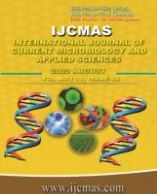


 National Academy of Agricultural Sciences (NAAS)
National Academy of Agricultural Sciences (NAAS)

|
PRINT ISSN : 2319-7692
Online ISSN : 2319-7706 Issues : 12 per year Publisher : Excellent Publishers Email : editorijcmas@gmail.com / submit@ijcmas.com Editor-in-chief: Dr.M.Prakash Index Copernicus ICV 2018: 95.39 NAAS RATING 2020: 5.38 |
The present study was carried out during 2020-21 with an aim to examine the production and post harvest losses of major oilseeds in in Mungeli district in Chhattisgarh state. The study’s focus was on two blocks that were carefully selected, namely Mungeli and Pathariya in the Mungeli district. There were 60 respondents overall, and the sample size was made up of 22, 18, 12, and 8 marginal, small, medium, and large farmers, respectively. A schedule for conducting interviews was used to collect the data, which was then appropriately statistically analysed. Age, education, sex, group size, occupation, annual income, and farm size were all examined as independent variables when examining the various characteristics of the respondents in order to learn more about the economics, post-harvest losses, disposal pattern, constraints, and suggestions for the major oilseed production in the study area. The total post-harvest losses for soybean and groundnut were determined to be 72.80 and 7.33, 91.96 and 7.31 kg per hectare and kg per quintal, respectively. For all of the major oilseeds, insufficient drying and threshing had the biggest impact on post-harvest losses. The highest marketable surplus was found in the disposal pattern for soybean, where it was higher at 95.96, followed by groundnut, where it was less at 88.35.The majority of the buyers of the oilseed farmers' produce were wholesalers and village merchants. All the groups faced problems regarding decreasing yield due to growing the crop regularly in same field as well as availability of labour in right time. In the case of soybean lack of processing unit is a main constraint in marketing of oilseeds this problems need to be rectified. According to the study, there is a need to improve oilseed storage, drying, threshing, productivity, marketing, and prices in order to decrease post-harvest losses, increase profitability, and improve marketing through suitable policy interventions.
 |
 |
 |
 |
 |